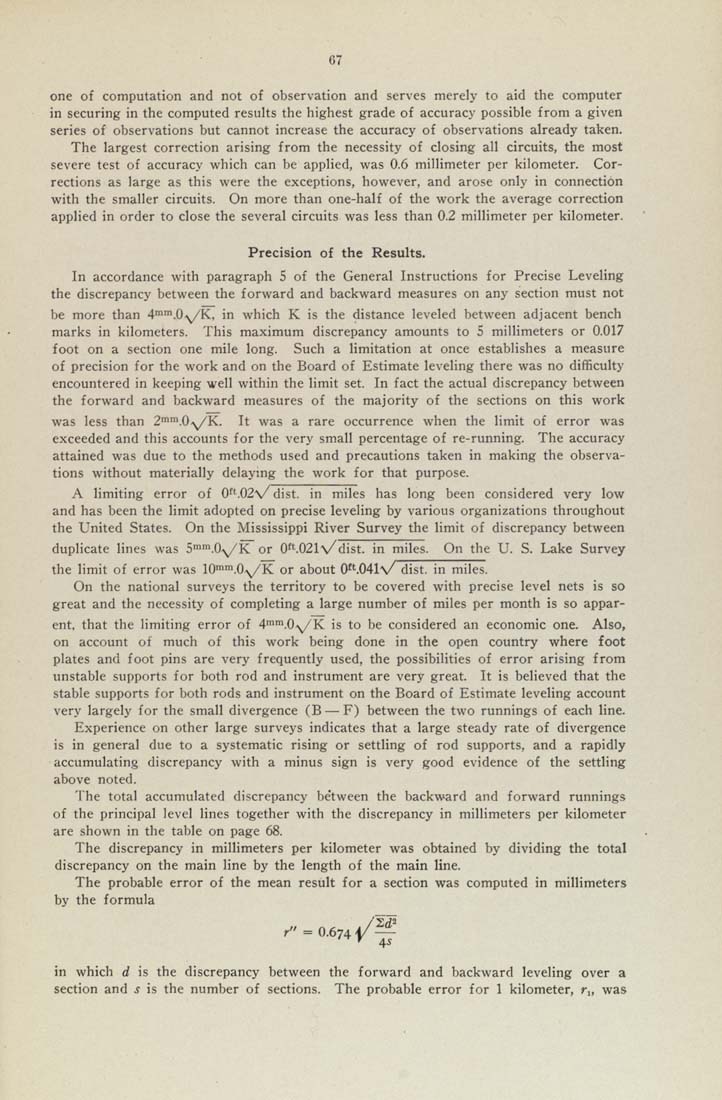one of computation and not of observation and serves merely to aid the computer
in securing in the computed results the highest grade of accuracy possible from a given
series of observations but cannot increase the accuracy of observations already taken.
The largest correction arising from the necessity of closing all circuits, the most
severe test of accuracy which can be applied, was 0.6 millimeter per kilometer. Cor¬
rections as large as this were the exceptions, however, and arose only in connection
with the smaller circuits. On more than one-half of the work the average correction
applied in order to close the several circuits was less than 0.2 millimeter per kilometer.
Precision of the Results.
In accordance with paragraph 5 of the General Instructions for Precise Leveling
the discrepancy between the forward and backward measures on any section must not
be more than 4'""'.0>/K, in which K is the distance leveled between adjacent bench
marks in kilometers. This maximum discrepancy amounts to 5 millimeters or 0.017
foot on a section one mile long. Such a limitation at once establishes a measure
of precision for the work and on the Board of Estimate leveling there was no difficulty
encountered in keeping well within the limit set. In fact the actual discrepancy between
the forward and backward measures of the majority of the sections on this work
was less than 2'"'".0,^K. It was a rare occurrence when the limit of error was
exceeded and this accounts for the very small percentage of re-running. The accuracy
attained was due to the methods used and precautions taken in making the observa¬
tions without materially delaying the work for that purpose.
A limiting error of 0f'.02v dist, in miles has long been considered very low
and has been the limit adopted on precise leveling by various organizations throughout
the United States. On the Mississippi River Survey the hmit of discrepancy between
duplicate lines was 5""".0^K or 0f^021\/dist. in miles. On the U. S. Lake Survey
the limit of error was 10""".0y/K or about 0",041\/ dist. in miles.
On the national surveys the territory to be covered with precise level nets is so
great and the necessity of completing a large number of mites per month is so appar¬
ent, that the limiting error of 4""".0y/'K is to be considered an economic one. Also,
on account of much of this work being done in the open country where foot
plates and foot pins are very frequently used, the possibilities of error arising from
unstable supports for both rod and instrument are very great. It is believed that the
stable supports for both rods and instrument on the Board of Estimate leveling account
very largely for the small divergence (B — F) between the two runnings of each line.
Experience on other large surveys indicates that a large steady rate of divergence
is in general due to a systematic rising or settling of rod supports, and a rapidly
accumulating discrepancy with a minus sign is very good evidence of the settling
above noted.
The total accumulated discrepancy be'tween the backward and forward runnings
of the principal level lines together with the discrepancy in millimeters per kilometer
are shown in the table on page 68.
The discrepancy in millimeters per kilometer was obtained by dividing the total
discrepancy on the main line by the length of the main line.
The probable error of the mean result for a section was computed in millimeters
by the formula
45
in which d is the discrepancy between the forward and backward leveling over a
section and s is the number of sections. The probable error for 1 kilometer, r,, was
= 0.6741/^
|








